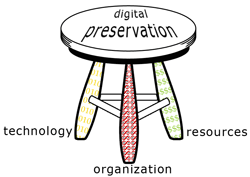A basic introduction to digital preservation storage. Part 1.
November 17, 2019
Introduction
Let’s talk about storage. I know, I know. Not the sexiest topic in the world. But, when it comes to your digital assets, thinking about storage and the various digital preservation actions that go along with it are core to the implementation, development, or enhancement of your digital preservation program. In this series of three blog posts, my goal is to communicate the value and need of digital preservation storage, the requirements to adhere to best practices, and provide some information and links to organizations that create and administer digital preservation storage standards.
I’m sure I am not going to satisfy everyone with the information in these blog posts, but keep in mind that this is meant as a basic introduction to digital preservation storage. Stay with me, though. I think there’s a little something for nearly every one in these posts.
What is digital preservation?
Before we can dive into the topic of digital preservation storage, we must first begin with a definition of “digital preservation.” Digital preservation is a formal endeavor to ensure that digital files of continuing value remain accessible and usable in the long-term by all stakeholders.2 It requires organizational commitment, resources, and technology to work in harmony to maintain a balanced digital preservation program.
The fundamental requirements of digital preservation are threefold:
- maintain the bits, or building blocks, of the digital files;
- maintain the content of the file (the picture in the digital image file, the text in the pdf file) so that it is accessible and understandable; and
- preserve both the bits and content for as long as necessary.
Digital preservation requires the active safekeeping of digitally stored files, and includes the practices required to ensure that files are safe from medium failures, as well as software and hardware obsolescence. These practices include ensuring the following:
- Sufficiency: Enough storage today and the flexibility for storage to grow over time.
- Redundancy: Three or more copies of digital files identified for long-term retention.
- Geographic diversity: Storage in at least two different natural disaster zones (e.g., flood, earthquake, hurricane, tornado).
- Integrity and attendance monitoring: Whether files have been corrupted (and replacing them if so) and whether files are where they are supposed to be.
- Obsolescence monitoring: Whether/when files or media are no longer accessible (or on the verge of no longer being accessible) and therefore must be migrated to a new format.
Why is digital preservation important?
The Digital Preservation Coalition (DPC), a UK-based not-for-profit organization with a broad international membership, provides on their website a guidance document called the Digital Preservation Handbook. In the introductory section, in answer to the statement, “Why Digital Preservation Matters,” the authors lay out the following argument.
“Pervasive, changing and ubiquitous, digital technologies are a defining feature of our age. Digital materials are a core commodity for industry, commerce, and government. They are fundamental for research, law, and medicine. The creative industries, cultural heritage, and the media depend on reliable access to digital materials while families and friends extend and sustain their relationships through digital interactions.
But digital materials — and the opportunities they create — are fragile even if they also have the capacity to be durable through replication. Digital platforms change and the long chains of interdependence on which they depend are complicated and fluid. Their longevity and utility is threatened where contents or contexts are lost: engagement and exploitation are enabled when digital materials endure. The greater the importance of digital materials, the greater the need for their preservation: digital preservation protects investment, captures potential, and transmits opportunities to future generations and our own.”3
Digital preservation isn’t just a choice institutions are making. For some institutions, and government institutions, in particular, maintaining records and providing public access to those records is mandated by law.4 This is true for physical records, born-digital records, and any digital surrogates created from physical ones, as these digital copies not only facilitate access, but may also become the only copy available when original records deteriorate or become obsolete.
I think that’s about enough to think about in a single blog post! We’ll continue our discussion in a later post, in which we’ll answer the questions:
- What is digital preservation storage and how is it different than traditional backups?
- What are the standards and who are the organizations that are leaders in writing and adhering to those standards?
Can’t wait? Here are a few questions to prepare for digital preservation storage. Once answered, you can begin to make decisions about what storage makes the best sense for your organization.
Also check out check out “Chapter 4: Managing digital audiovisual collections” in Fundamentals of AV Preservation, written by (me and other) AVPeeps for the NEDCC.
Next blog posts:
A Basic Introduction To Digital Preservation Storage. Part 2 by Amy Rudersdorf
A Basic Introduction To Digital Preservation Storage. Part 3 by Amy Rudersdorf
1 See blog post title
2 Yes, I took some of this from Wikipedia
3 For a full discussion of this topic, please see this section of the Digital Preservation Handbook
4 See, for example, the requirements of State of California for access to public records
